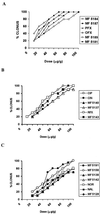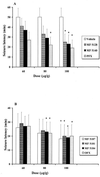Effects of novel 6-desfluoroquinolones and classic quinolones on pentylenetetrazole-induced seizures in mice
- PMID: 10390231
- PMCID: PMC89352
- DOI: 10.1128/AAC.43.7.1729
Effects of novel 6-desfluoroquinolones and classic quinolones on pentylenetetrazole-induced seizures in mice
Abstract
There have been several reports that convulsions, although rare, occur in patients who receive fluoroquinolones. In this study, the proconvulsant effects exhibited by a novel series of 6-desfluoroquinolones and some classic quinolones on pentylenetetrazole (PTZ)-induced seizures in mice were evaluated and compared. Animals were intraperitoneally injected with vehicle or quinolone derivatives (5 to 100 microg/g of body weight) 30 min before the subcutaneous (s.c.) administration of PTZ (40 microg/g). In each experiment, mice were then observed for 1 h to monitor for the incidence and onset of clonic seizures. The order of proconvulsant activity in our epileptic model was MF5184 > MF5187 > pefloxacin > MF5189 > ofloxacin > ciprofloxacin > MF5140 > MF5181 > MF5137 > rufloxacin > MF5143 > MF5158 > MF5191 > MF5128 > MF5138 > cinoxacin > MF5142 > norfloxacin > nalidixic acid. The relationship between the chemical structure and the proconvulsant activity of 6-desfluoroquinolone derivatives was studied. We observed that, in terms of toxicity to the central nervous system (CNS), besides the heterocyclic side chain (moiety) at the C-7 position, the C-6 substituent also appears to play an important role. In particular, a hydrogen at the C-6 position seemed to be responsible for major neurotoxic activity in comparison to an amino group located in the same position. The relationship between lipophilicity and proconvulsant activity was also investigated. We did not find any clear relationship between a higher level of lipophilicity and major proconvulsant properties. Although the principal mechanism by which quinolones induce potentiation of the proconvulsant effects of PTZ cannot be easily determined, it is possible that the convulsions are caused by drug interactions, because both PTZ and quinolones are believed to increase excitation of the CNS by inhibition of gamma-aminobutyric acid binding to receptors.
Figures





References
-
- Anastasio G D, Menscer D, Little J M., Jr Norfloxacin and seizures. Ann Intern Med. 1988;109:169–170. - PubMed
-
- Cecchetti V, Clementi S, Cruciani G, Fravolini A, Pagella P G, Savino A, Tabarrini O. 6-Aminoquinolones: a new class of quinolone antibacterials? J Med Chem. 1995;38:973–982. - PubMed
-
- Cecchetti V, Fravolini A, Lorenzini M C, Tabarrini O, Terni P, Xin T. Studies on 6-aminoquinolones: synthesis and antibacterial evaluation of 6-amino-8-methylquinolones. J Med Chem. 1996;39:436–445. - PubMed
Publication types
MeSH terms
Substances
LinkOut - more resources
Full Text Sources
Other Literature Sources
Medical
Miscellaneous

